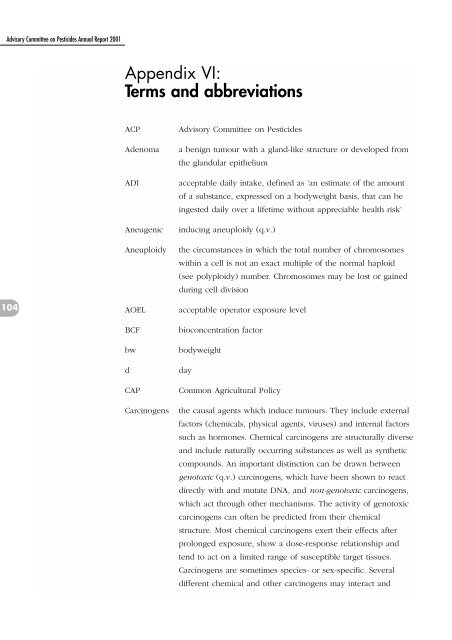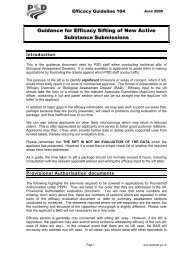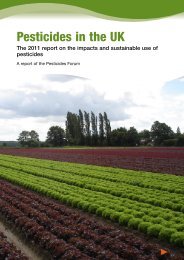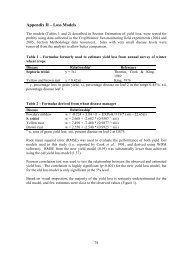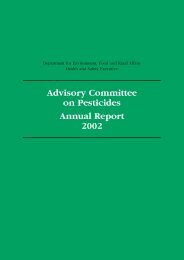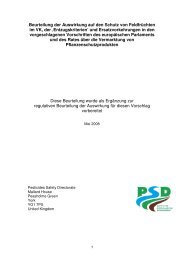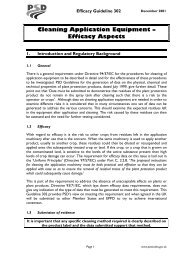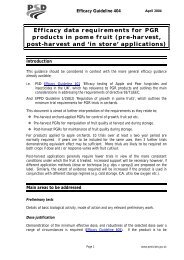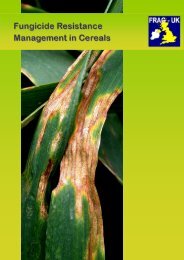Advisory Committee on Pesticides Annual Report 2001
ACP Annual Report 2001 - Pesticides Safety Directorate
ACP Annual Report 2001 - Pesticides Safety Directorate
Create successful ePaper yourself
Turn your PDF publications into a flip-book with our unique Google optimized e-Paper software.
<str<strong>on</strong>g>Advisory</str<strong>on</strong>g> <str<strong>on</strong>g>Committee</str<strong>on</strong>g> <strong>on</strong> <strong>Pesticides</strong> <strong>Annual</strong> <strong>Report</strong> <strong>2001</strong><br />
Appendix VI:<br />
Terms and abbreviati<strong>on</strong>s<br />
104<br />
ACP<br />
Adenoma<br />
ADI<br />
Aneugenic<br />
Aneuploidy<br />
AOEL<br />
BCF<br />
bw<br />
d<br />
CAP<br />
Carcinogens<br />
<str<strong>on</strong>g>Advisory</str<strong>on</strong>g> <str<strong>on</strong>g>Committee</str<strong>on</strong>g> <strong>on</strong> <strong>Pesticides</strong><br />
a benign tumour with a gland-like structure or developed from<br />
the glandular epithelium<br />
acceptable daily intake, defined as ’an estimate of the amount<br />
of a substance, expressed <strong>on</strong> a bodyweight basis, that can be<br />
ingested daily over a lifetime without appreciable health risk’<br />
inducing aneuploidy (q.v.)<br />
the circumstances in which the total number of chromosomes<br />
within a cell is not an exact multiple of the normal haploid<br />
(see polyploidy) number. Chromosomes may be lost or gained<br />
during cell divisi<strong>on</strong><br />
acceptable operator exposure level<br />
bioc<strong>on</strong>centrati<strong>on</strong> factor<br />
bodyweight<br />
day<br />
Comm<strong>on</strong> Agricultural Policy<br />
the causal agents which induce tumours. They include external<br />
factors (chemicals, physical agents, viruses) and internal factors<br />
such as horm<strong>on</strong>es. Chemical carcinogens are structurally diverse<br />
and include naturally occurring substances as well as synthetic<br />
compounds. An important distincti<strong>on</strong> can be drawn between<br />
genotoxic (q.v.) carcinogens, which have been shown to react<br />
directly with and mutate DNA, and n<strong>on</strong>-genotoxic carcinogens,<br />
which act through other mechanisms. The activity of genotoxic<br />
carcinogens can often be predicted from their chemical<br />
structure. Most chemical carcinogens exert their effects after<br />
prol<strong>on</strong>ged exposure, show a dose-resp<strong>on</strong>se relati<strong>on</strong>ship and<br />
tend to act <strong>on</strong> a limited range of susceptible target tissues.<br />
Carcinogens are sometimes species- or sex-specific. Several<br />
different chemical and other carcinogens may interact and


